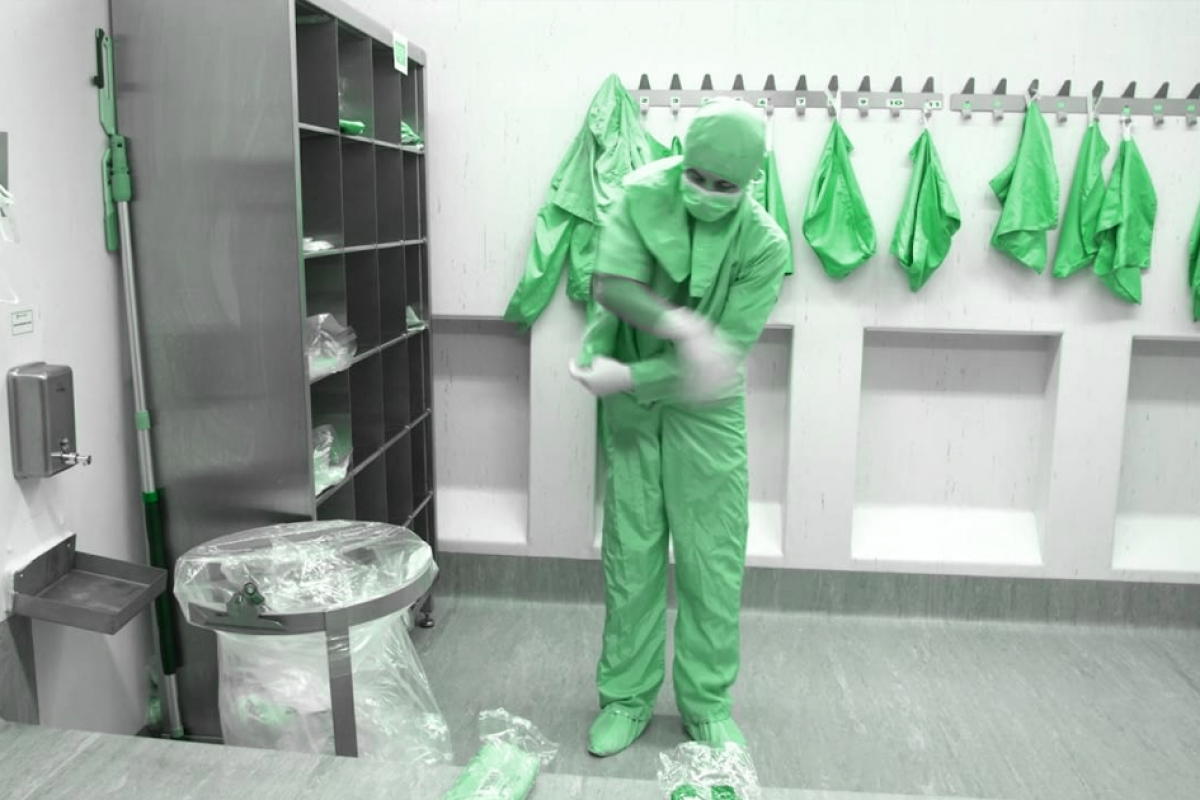
Sterile Gloving Technique for Cleanrooms
Cleanroom gloves are worn for one of two reasons: to protect the wearer from exposure to dangerous or irritative substances, and to protect cleanroom products from contaminants introduced through operators, equipment, or airborne particles. Pharmaceutical manufacturers will generally require sterile gloves with cleanroom designated packaging. Standard surgical glove packaging generally uses a polycellulose spunwoven fabric which generates a high count of particles when opened and handled. Cleanroom glove packaging features a polyethylene, easy open packaging which is washed with deionized water, assembled in an ISO Class 4 cleanroom, and then packaged for delivery in an ISO Class 5 Cleanroom.
Best Practices for Donning Cleanrooms Gloves
You Should:
- Use sterile gloves for cleanroom and aseptic processing, and never use powdered gloves.
- Dry hands completely before donning gloves
- Don dominant hand first
- Use wall mount consumable dispenser for easy access and less movement
You Should Not:
- Wear jewelry, fingernail polish, or cosmetics.
- Do not wave gloved hands to speed drying after applying alcohol solution.
- Never touch exposed skin with a gloved hand.
Cleanroom Gowning Procedure and Protocol
Cleanroom gowning protocol differs depending on cleanroom class and application. In ISO Class 7 or ISO Class 8 cleanrooms, frocks are often acceptable. A cleanroom classified as ISO Class 5 or ISO Class 6 (or cleaner) requires cleanroom coveralls, along with hoods, gloves, and booties (shoe covers). For sterile processing, additional precaution is needed to assure that no sterile surfaces contact non-sterile surfaces during gowning, processing, or cleaning.
Cleanroom Gowning Procedure Checklist
- Before entering gowning room taking at least three small steps with each foot; remove dirty sticky mat layer if needed.
- Use a shoe brush cleaner
- Don shoe cover booties
- Don cleanroom bouffant
- Wash hands thoroughly (use waterless alcohol solution for USP 797)
- Put on cleanroom glove liners
- Apply alcohol solution to outside of liners
- Put on cleanroom gloves
- Wash or apply alcohol solution to cleanroom gloves
- Apply cleanroom bouffant (beard covers for those with facial hair)
- Apply a freshly laundered cleanroom hood
- Attach facemask
- Apply coveralls, only touch the floor on the clean side of a gowning bench
- Hoods are tucked inside of coveralls
- Put on cleanroom booties
- Put on cleanroom gloves
- Ensure that booties and gloves overlap the coveralls
- Wipedown the gowning bench with a clean, sterile wiper
- Use cleanroom mirror for self-check
- USP 797 Protocol and Gowning Requirements
- While USP 797 provides a dedicated order for personnel cleansing and garbing, these specifications may change according to state regulation. For help regarding localized requirements, contact an expert.
USP 797 Personnel Cleansing and Garbing Best Practices
You Should:
- Do include employees in the quality assurance process and keep them informed of positive and negative hygiene or procedure evaluations.
- Careful and thorough hand cleansing is essential hygiene performed in the anteroom and prior to donning a non-shedding gown.
- Ensure that operators of all shapes and body sizes have access to properly fitting garments.
- Wash hands and forearms up to the elbows for at least 30 seconds with soap and water in the ante-area. (either non-antimicrobial or antimicrobial soap)
You Should Not
- Don’t use scrub brushes on the hands as any skin damage increases skin shedding.
- Don’t use any type of drying wipe except disposable wipes or an electronic hand dryer with HEPA filtration
- Don’t don a gown before completing proper hand hygiene, as splashes from the sink while wearing a non-shedding gown could be a source of microbial contamination.
The proper cleanroom gowning supplies and equipment is an essential component of cleanroom contamination control. This informational guide should never take precedence over consulting with a cleanroom engineering consultant who is familiar with your specific equipment and classification needs.
Cleanroom Garments - Considerations for launderable and disposable cleanroom garments.
The requirements for disposal and use of gowns and garments differs upon cleanroom classification and application. The cleanest cleanrooms dispose of garments after each exit and entry, while cleanrooms with the highest particle thresholds may only change garments twice a week.
Compounding personnel generally prefer gowns that snap or button in the front for easy use, but USP Chapter 797 does not specify a requirement.
All garbs, except for the launderable cleanroom gowns must be disposed of after exiting the cleanroom compounding area.
Resources & Articles
CLIN ® "Resources" page is for individuals/companies seeking information on cleanrooms and controlled environments. Find Cleanroom News, Discussion Forums, Cleanroom Cleaning Recommendations, Cleanroom Terminology, Cleanroom Directory, and more.
Content Disclaimer
Information are contributed by/from different websites and all credit goes to its respective owners/writers/websites/companies and etc, and while we endeavour to keep the information up to date and correct, we make no representations or warranties of any kind, express or implied, about the completeness, accuracy, reliability, suitability or availability with respect to the website or the information, products, services, or related graphics contained on the website for any purpose. Any reliance you place on such information is therefore strictly at your own risk.
In no event will we be liable for any loss or damage including without limitation, indirect or consequential loss or damage, or any loss or damage whatsoever arising from loss of data or profits arising out of, or in connection with, the use of this website.
Through this website you are able to link to other websites which are not under the control of respective owners/writers/websites/companies and etc. We have no control over the nature, content and availability of those sites. The inclusion of any links does not necessarily imply a recommendation or endorse the views expressed within them.
Every effort is made to keep the website up and running smoothly. However, CLIN ® takes no responsibility for, and will not be liable for, the website being temporarily unavailable due to technical issues beyond our control.











